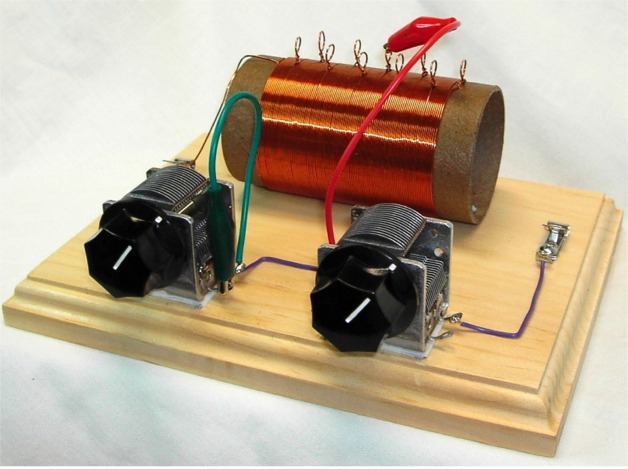

Alfred P. Morgan was a prolific early writer of books on the subjects of
electricity, wireless telegraphy, and radio. His works were written for young
people and the average man who wasn't an expert in mathematics and physics.
His book, "THE BOY ELECTRICIAN", originally published in 1913 and many
printings after, taught many a youngster how to make crystal radios, wireless
transmitters, antennas, and all kinds of electrical experiments. Many young
people who built Morgan's projects later became engineers and scientists.
This great little antenna tuner is named after Alfred P. Morgan for his
influence on the lives and careers of many people. In the early days of
wireless, very low frequency, very long wavelength signals were used. These
extremely long wavelengths required exceptionally long antennas in order to be
resonant. It was impractical to have antennas that were thousands of feet long,
so early designers found a way around this problem by using "loading coils" to
artificially lengthen their antennas. These loading coils were adjustable coils
of wire, or Inductors. A variable capacitor was often added in parallel with
the loading coils to "fine tune" their shorter antennas to the resonance of a
much longer antenna. During the 1920s, amateur radio experimenters discovered
that shorter wavelength signals would "skip" off the Ionosphere and thus
allowed very long distance communications using low transmitter power on the
"Short Wave" bands. Many antennas were too long to resonate at these shorter
wavelengths. The designers found that a variable capacitor connected in-series
with the antenna allowed it to be tuned to resonance at the higher frequency
short wavelengths. Because we like to operate on multiple frequencies, loading
coils with parallel-connected variable capacitors and series capacitors were
combined into one circuit and were then called "Antenna Tuners." The Morgan
Crystal Radio Antenna Tuner works to tune random wire antennas from
approximately fifty feet and longer for crystal sets and more complex radios on
the A.M. Broadcast Band, Short Wave and Amateur Bands up to about 30 MHZ. By
tuning your antenna to resonance, it will transfer the energy from the received
radio wave to your set more efficiently. This will result in a louder signal
that will allow weaker "DX" stations to be heard that were not audible before.
This antenna tuner can also be used to increase the selectivity of simple
receivers. This feature helps to separate the faint DX stations from the strong
locals. Building this antenna tuner is accomplished using simple assembly
techniques and high quality parts. The air variable capacitors are the same
fine American-made units that we use on our Armstrong One Tube Radio Kits,
Dunwoody High Performance Crystal Radio Kits, and Bucher Crystal Radio QRM
Rejectors. This kit is based on our ELECTRONICS HANDBOOK Magazine article,
"How To Build And Use A Crystal Set Antenna Tuner", reprints of which are
available in our "Literature" Link. This is an improved version of that antenna
tuner. Clip-leads are used for the coil tap connections and for shorting the
series capacitor when it is not in use. The clip-leads simplify construction
and eliminate the signal-robbing losses that result from the use of a rotary
switch and its many leads. Very good results can be expected with this antenna
tuner. It has been used successfully used with our Dunwoody High Performance
Crystal Radio and with our Armstrong One Tube Radio. It also works well with
our Cornell WW-II Foxhole Radio and our Pickard Crystal Radio. It has been
used with antique radios and commercial communications receivers. In addition
to this, it can be used with low power "QRP" amateur radio transmitters to
match the transmitter's output impedance to an end-fed wire antenna. One
customer says, "This antenna tuner will increase the number of A.M. DX stations
received on a one-tube set ten-fold!" Highest quality parts are used
throughout. The pre-drilled routed baseboard is made for us by TOLEWOOD.COM
from clear furniture grade pine that can be stained for an attractive vintage
look. The pre-punched coil form is made from the same heavy cardboard shipping
tube as our Dunwoody High Performance Crystal Set. Quality black Bakelite
knobs contribute to the vintage appearance. Nickel-plated brass fahnestock
clips are used for the input and output connections. All parts, screws,
clip-leads, and wire are included in this fine quality kit. The
easy-to-understand instructions were designed for beginners, however the coil
winding is at a level of difficulty for more experienced builders. Soldering
is required.
Complete kit including all parts and easy to follow instructions:
Source: http://www.xtalman.com/kits.html
|